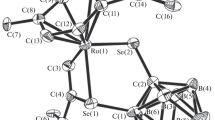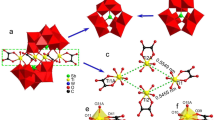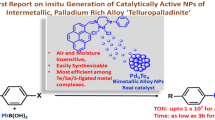Abstract
Thioselenohalide complexes Mo2(μ-S2)2Cl6(SeCl2)2 (I), Mo2(μ-S2)2Br6(SeBr2)2 (II), and W2(μ-S2)2Br6(SeBr2)2 (III) were synthesized by the reactions of corresponding metal halides or carbonyls or molybdenum metal with excesses of S2 X 2+Se2 X 2 mixtures. The complex W2(μ-S2)2Cl6(SeCl2)2 (IV) was obtained by an exchange reaction between (III) and excess of Se2Cl2. Coordination of the neutral SeX 2 ligands to thiohalidesM 2(μ-S2)2 X 6 results in higher thermal stability, and suggests the possibility to synthesize SeX 2 complexes of the unstable parent tungsten thiohalides. An unusual oxidative addition reaction of (I) was detected: {fx27-1} Both (I) and (IV) were characterized by X-ray crystal structure analysis. They are isostructural and form discrete molecules. Bridging S 2−2 ligands are coordinated perpendicularly to the metal-metal bond;d(M−M)=2.8066 Å and 2.793 Å for I and IV, respectively. Nonequivalence of chlorine atoms which are bound to the metal atom, relate to nonequivalence of halogen atoms in the complexesM 2(μ−S2)2 X 2−8 . Chlorine atomstrans to SeCl2 ligands form short bonds with the metal; the corresponding35Cl NQR frequency is increased. The selenium dichloride ligand is ambidentate. The selenium atom binds as a donor to the metal and as an acceptor to two chlorine atoms which are also bound covalently to the same metal atom.
Similar content being viewed by others
References
T. Saito,in M. H. Chisholm (ed.),Early Transition Metal Clusters with π-Donor Ligands (VCH Publishers, New York, 1995), pp. 63–164.
J.-C. Gabriel, K. Boubekeur, and P. Batail (1993).Inorg. Chem. 32, 2894.
A. Müller, E. Krickemeyer, H. Bögge, H. Ratajczak, and A. Armatage (1994).Angew. Chem. Int. Ed. Engl. 33(7), 770.
N. I. Timoshchenko, V. L. Kolesnichenko, S. V. Volkov, Yu. L. Slovokhotov, and Yu. T. Struchkov (1990).Russ. J. Coord. Chem. 16(8), 567.
L. A. Aslanov, S. V. Volkov, V. L. Kolesnichenko, T. B. Mischanchuk, V. B. Rybakov, and N. I. Timoshchenko (1991).Soviet Progress in Chemistry (Ukr. Khim. Zh.).57(7), 1.
N. S. Fortunatov and N. I. Timoshchenko (1965).Ukr. Khim. Zh. 31(10), 1078.
S. V. Volkov, V. L. Kolesnichenko, and N. I. Timoshchenko (1988).Russ. J. Inorg. Chem. 33(4), 459.
J. Marcoll, A. Rabenau, D. Mootz, and H. Wunderlich (1974).Rev. Chim. Miner. 11(5), 607.
D. Fenske, B. Czeska, C. Schumacher, R. E. Schmidt, and K. Dehnicke (1985).Z. Anorg. Allg. Chem. 520(1), 7.
C. D. Borman, V. P. Fedin, M. C. Hong, G. J. Lamprecht, C. H. Kwak, C. A. Routledge, D. M. Saysell, and A. G. Sykes (1995).Pure Appl. Chem. 67(2), 305.
N. S. Fortunatov and N. I. Timoshchenko (1969).Ukr. Khim. Zh. 35(11), 1207.
F. A. Cotton, P. A. Kibala, M. Matusz, C. S. McCaleb, and R. B. W. Sandor (1989).Inorg. Chem. 28, 2623.
V. P. Fedin, M. N. Sokolov, O. A. Geras’ko, B. A. Kolesov, V. Ye. Fedorov, A. V. Mironov, D. S. Yufit, Yu. L. Slovokhotov, and Yu. T. Struchkov (1990).Inorg Chim. Acta. 175, 217.
T. Saito, A. Yoshikawa, T. Yamagata, H. Imoto, and K. Unora (1989).Inorg. Chem. 28, 3588.
A. V. Virovets, Yu. L. Slovokhotov, Yu. T. Struchkov, V. E. Fedorov, Yu. V. Mironov, and V. P. Fedin (1990).Koord. Khim. 16(2), 198.
V. L. Kolesnichenko, S. P. Sharavskaya, O. G. Yanko, and S. V. Volkov (1993).Russ. J. Inorg. Chem. 38(7), 1011.
V. M. Belousov, T. A. Pal’chevskaya, S. V. Volkov, V. L. Kolesnichenko, L. V. Bogutskaya, and S. P. Sharavskaya (1992).Theoret. Exp. Chem. 28(3), 194.
S. V. Volkov, Yu. N. Mikhailov, V. L. Kolesnichenko, A. S. Kanishcheva, and N. I. Timoshchenko (1988).Koord. Khim. 14(3), 363.
S. V. Volkov, V. L. Kolesnichenko, and N. I. Timoshchenko (1988).J. Coord. Chem. 17, 367.
H. Stammreich and R. Forneris (1956).Spectrochim. Acta. 8, 46.
G. Brauer (ed.),Handbuch der Präparativen Anorganischen Chemie (Ferdinand Enke Verlag, Stuttgart, 1981).
S. V. Volkov, Z. A. Fokina, V. F. Lapko, V. E. Pogorelov, and G. I. Salivon (1982).Ukr. Khim. Zh. 48, 899.
H. G. Stammler and J. Weiss (1989).Z. Naturforsch. 44b, 1483.
B. Krebs, E. Lührs, R. Willmer, and F.-P. Ahlers (1991).Z. Anorg. Allg. Chem. 592, 17.
F. A. Cotton, P. A. Kibala, and R. B. W. Sandor (1989).Acta Cryst. C45, 1287.
K. Nakamoto,Infrared and Raman Spectra of Inorganic and Coordination Compounds (John Wiley & Sons, New York, 1986), p. 128.
J. Q. Lee, M. L. Sampson, J. F. Richardson, and M. E. Noble (1995).Inorg. Chem. 34, 5055.
S. V. Volkov and V. I. Pekhn’o (1993).Russ. J. Coord. Chem. 19(6), 524.
B. Krebs, A. Schäffer, and S. Pohl (1984).Z. Naturforsch. 39b, 1633.
Author information
Authors and Affiliations
Rights and permissions
About this article
Cite this article
Kolesnichenko, V.L., Rybakov, V.B., Aslanov, L.A. et al. Synthesis, structure and reactivity of binuclear metal-metal bonded molybdenum(V) and tungsten(V) thioselenohalides: Molecular structure of Mo2(μ-S2)2Cl6(SeCl2)2 and W2(μ-S2)2Cl6(SeCl2)2 . J Clust Sci 8, 27–45 (1997). https://doi.org/10.1007/BF02764127
Received:
Issue Date:
DOI: https://doi.org/10.1007/BF02764127




